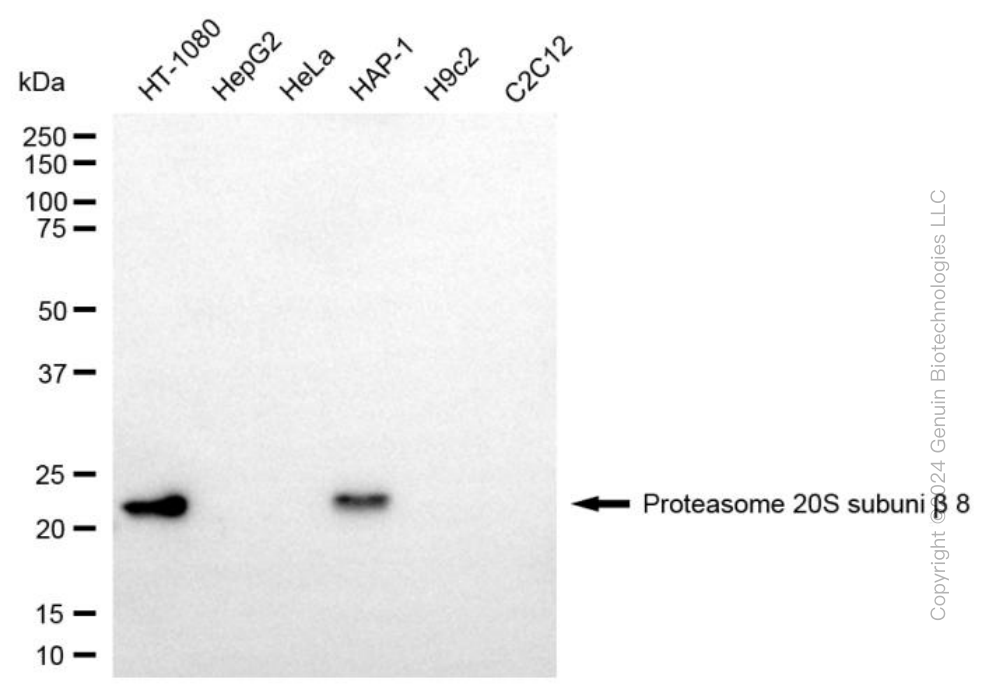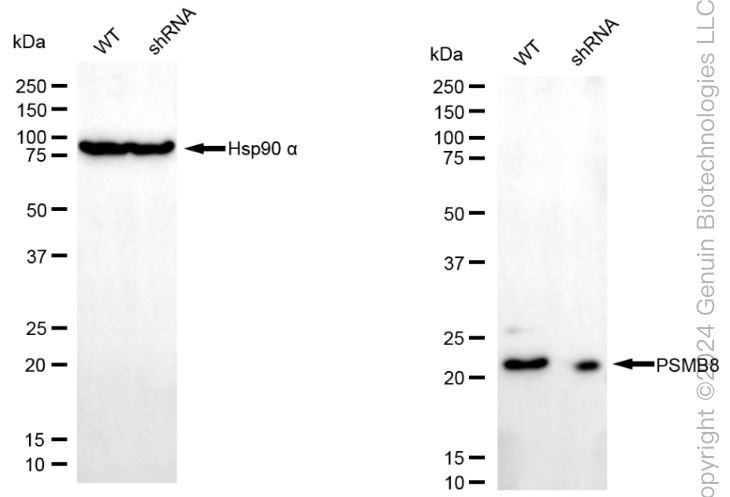KD-Validated Anti-PSMB8 Mouse Monoclonal Antibody
Mouse monoclonal antibody
- SPECIFICATION
- CITATIONS
- PROTOCOLS
- BACKGROUND

Application
| WB |
|---|---|
| Primary Accession | P28062 |
| Reactivity | Human |
| Clonality | Monoclonal |
| Isotype | Mouse IgG1 |
| Clone Names | 24GB6765 |
| Calculated MW | Predicted, 30 kDa, observed, 23 kDa |
| Gene Name | PSMB8 |
| Aliases | PSMB8; Proteasome 20S Subunit Beta 8; RING10; PSMB5i; D6S216E; LMP7; Multicatalytic Endopeptidase Complex Subunit C13; Really Interesting New Gene 10 Protein; Proteasome Subunit Beta Type-8; Low Molecular Mass Protein 7; Proteasome Subunit Beta 8; Proteasome Component C13; Macropain Subunit C13; EC 3.4.25.1; Beta5i; Proteasome (Prosome, Macropain) Subunit, Beta Type, 8 (Large Multifunctional Peptidase 7); Proteasome (Prosome, Macropain) Subunit, Beta Type, 8 (Large Multifunctional Protease 7); Proteasome (Prosome, Macropain) Subunit, Beta Type, 8; Large Multifunctional Peptidase 7; Proteasome Catalytic Subunit 3i; Low Molecular Weight Protein 7; Proteasome Subunit Beta 5i; Proteasome Subunit Beta-5i; Proteasome-Related Gene 7; Proteasome Subunit Β5i; Protease Component C13; Proteasome Subunit Y2; D6S216; PRAAS1; ALDD; NKJO; JMP; Y2 |
| Immunogen | Recombinant protein of human PSMB8 |
| Gene ID | 5696 |
|---|---|
| Other Names | Proteasome subunit beta type-8, 3.4.25.1, Low molecular mass protein 7, Macropain subunit C13, Multicatalytic endopeptidase complex subunit C13, Proteasome component C13, Proteasome subunit beta-5i, Really interesting new gene 10 protein, PSMB8, LMP7, PSMB5i, RING10, Y2 |
| Name | PSMB8 |
|---|---|
| Synonyms | LMP7, PSMB5i, RING10, Y2 |
| Function | The proteasome is a multicatalytic proteinase complex which is characterized by its ability to cleave peptides with Arg, Phe, Tyr, Leu, and Glu adjacent to the leaving group at neutral or slightly basic pH. The proteasome has an ATP-dependent proteolytic activity. This subunit is involved in antigen processing to generate class I binding peptides. Replacement of PSMB5 by PSMB8 increases the capacity of the immunoproteasome to cleave model peptides after hydrophobic and basic residues. Involved in the generation of spliced peptides resulting from the ligation of two separate proteasomal cleavage products that are not contiguous in the parental protein (PubMed:27049119). Acts as a major component of interferon gamma-induced sensitivity. Plays a key role in apoptosis via the degradation of the apoptotic inhibitor MCL1. May be involved in the inflammatory response pathway. In cancer cells, substitution of isoform 1 (E2) by isoform 2 (E1) results in immunoproteasome deficiency. Required for the differentiation of preadipocytes into adipocytes. |
| Cellular Location | Cytoplasm {ECO:0000255|PROSITE-ProRule:PRU00809}. Nucleus |

Thousands of laboratories across the world have published research that depended on the performance of antibodies from Abcepta to advance their research. Check out links to articles that cite our products in major peer-reviewed journals, organized by research category.
info@abcepta.com, and receive a free "I Love Antibodies" mug.
Provided below are standard protocols that you may find useful for product applications.
If you have used an Abcepta product and would like to share how it has performed, please click on the "Submit Review" button and provide the requested information. Our staff will examine and post your review and contact you if needed.
If you have any additional inquiries please email technical services at tech@abcepta.com.














 Foundational characteristics of cancer include proliferation, angiogenesis, migration, evasion of apoptosis, and cellular immortality. Find key markers for these cellular processes and antibodies to detect them.
Foundational characteristics of cancer include proliferation, angiogenesis, migration, evasion of apoptosis, and cellular immortality. Find key markers for these cellular processes and antibodies to detect them. The SUMOplot™ Analysis Program predicts and scores sumoylation sites in your protein. SUMOylation is a post-translational modification involved in various cellular processes, such as nuclear-cytosolic transport, transcriptional regulation, apoptosis, protein stability, response to stress, and progression through the cell cycle.
The SUMOplot™ Analysis Program predicts and scores sumoylation sites in your protein. SUMOylation is a post-translational modification involved in various cellular processes, such as nuclear-cytosolic transport, transcriptional regulation, apoptosis, protein stability, response to stress, and progression through the cell cycle. The Autophagy Receptor Motif Plotter predicts and scores autophagy receptor binding sites in your protein. Identifying proteins connected to this pathway is critical to understanding the role of autophagy in physiological as well as pathological processes such as development, differentiation, neurodegenerative diseases, stress, infection, and cancer.
The Autophagy Receptor Motif Plotter predicts and scores autophagy receptor binding sites in your protein. Identifying proteins connected to this pathway is critical to understanding the role of autophagy in physiological as well as pathological processes such as development, differentiation, neurodegenerative diseases, stress, infection, and cancer.



